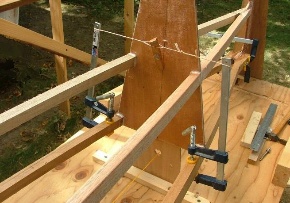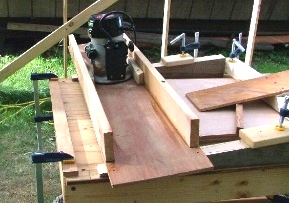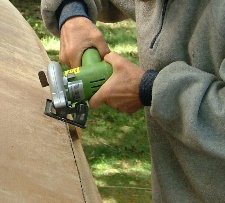





Hatch Covers for the W17 cockpit bulkheads
Since April 2018, the plywood kit now includes maximum size openings in the fore and aft cockpit bulkheads and these will need to be closed with plywood hatch covers. Here is what is suggested.
FORWARD BULKHEAD: The forward one needs to be reasonably watertight, as it’s a good place to store dry items and also, in the rare event of a flip, maintaining buoyancy forward is important.
Here is a plywood cover that has wood cleats attached to the bottom that hook-over the small 40mm proposed coaming. The panel seals with a length of 3/8” braided cotton rope bonded to the cover with a 3mm wide strip of epoxy. A small rubber tube could also be used. The bonding can be achieved by laying down two masking tapes 3mm
On the boat, the hatch is retained in place with two rotating toggles at the top, with a small taper on their inside surface and just enough clearance, to put a little pressure on the cotton rope seal.
AFT BULKHEAD: The aft hatch hole will need to sit a little higher than the forward one, as water will slop and collect on the cockpit floor aft for a little
So the proposed coaming here is approx. 60mm high. But above that, the cover will not really need a gasket to be as watertight as the forward one as one may choose to even flood the after locker in the event of a rare flip, so that the boat can sink by the stern, be rotated ‘bow over stern’, to come back upright again.
Experience has also shown that having a safe but readily accessible pocket for say a camera, cap, gloves or sunglasses etc. is a very useful addition. So I am proposing an idea that I first developed some 60+ years ago for another small boat and have successfully used a few times since. It’s a lightweight pocket mostly of 3mm ply that pivots open to about 35-40 deg, held by stoppers on the end of two plywood springs over the sides of the box (see sketch below). When the ‘springs’ (cut 20mm wide from
For top access to the Aft Compartment, my latest recommendation (2019) is to have one large, rectangular 'drop-over' wood hatch (of similar style to the forward one with a 19mm coaming) and of about 350 x 250 clear-opening. Set this transversely on the centerline, starting about 50mm aft of the rear face of the aft mainbeam. This gives the very best, easy vertical access to the large compartment each side of the tiller and is the recommended location for a stove plus food stuff when camping. The low cover can best be arranged to slide aft, so that it can stay flat on the aft deck and not be in the way. 200 x 200 hatches port and starboard further aft, are another option, but not as effective for easy access.
Read more Construction Tips & Techniques.
"New articles, comments
"See the Copyright Information & Legal Disclaimer page for copyright info and use of ANY part of this text or article"